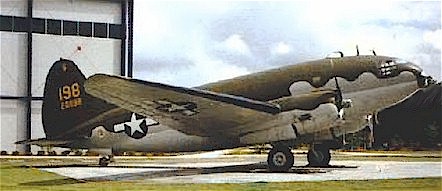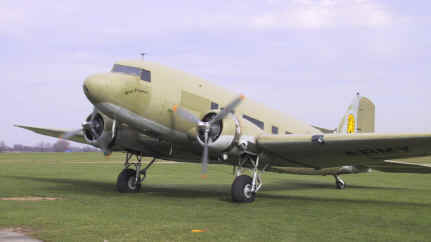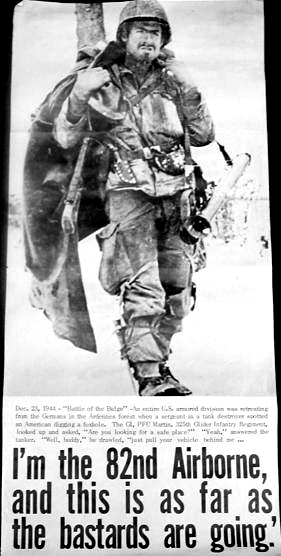|
Air Power
"The Glider Haulers"

C-46 "Commando"

Douglas C-47 Skytrain / Dakota
|
C-46 History:
In March 1940, the Curtiss-Wright company first flew a new 36-seat commercial airliner design, designated the CW-20. The US Army became interested in the aircraft for its cargo/transport capabilities, and ordered a militarized version, the C-46 Commando, be produced, utilizing two 2,000-hp Pratt & Whitney R-2800-43 engines. The Commando entered service with the USAAF in July 1942, becoming the largest and heaviest twin-engine aircraft in the Air Corps.
The first major variant to appear was the C-46A, which had a large cargo door in the left rear fuselage, 40 folding seats, a strengthened cargo floor, and higher-altitude capable engines. This last feature was to become important when the C-46 began flying cargo "over the Hump" from India to China. The C-46 was found to have much better load-hauling capabilities than the C-47 at the altitudes involved. The Commando also served in the Pacific theater, where it moved troops and supplies from island to island, contributing to the defeat of Japan. In the European Theater, C-46s served as glider tugs, towing two CG-4 gliders at a time across the Rhine River.
Other versions of the aircraft included the R5C-1 (US Navy/Marine Corps designation); the C-46D (personnel version with an extra door on the right side); C-46E (utility version with C-46A doors and a stepped windscreen); and C-46F (cargo model with doors on both sides and square wingtip ends).
Well over 3,000 Commandos were built, and they remained in service through the Korean War. A few even served during the first years of the war in Vietnam. Today, a small number continue to fly in various capacities around the world, mostly as freighters in Central and South America.
Nicknames: Whale; T-Cat (C-46s modified to U.S. Civil Aviation transport-category standards.)
Specifications: (C-46A)
Engines: Two 2,000-hp Pratt & Whitney R-2800-51 radial piston engines
Weight: Empty 30,000 lbs., Max Takeoff 45,000 lbs.
Wing Span: 108ft. 0in.
Length: 76ft. 4in.
Height: 21ft. 9in.
Maximum Speed: 270 mph
Cruising Speed: 173 mph
Ceiling: 24,500 ft.
Range: 3,150 miles
Armament: None
Number Built: 3,000+
Number Still Flying: 50+ (amazing huh?)
C-47 History:
The Douglas DC-3 was born of the intense competition for modern commercial aircraft that characterized the post-World War I era. It was the direct descendant of the DC-1, which first flew in 1933 as Douglas' initial response to a short supply of competitor, Boeing Aircraft's, landmark 10-passenger 247, the first, low-wing, all-metal airliner. With only one 12-passenger sample flying, and already a record-breaking success, the DC-1 was quickly made obsolete, replaced by an a more powerful version with greater seating capacity, the 14-passenger DC-2, of which 193 were built.
When, in 1934, American Airlines asked Douglas for a larger version of the DC-2 that would permit sleeping accommodations for transcontinental flights, Douglas responded with the 24 passenger (16 as a "sleeper" craft) DST (Douglas Sleeper Transport), the 24-passenger version of which was designated DC-3.
The DC-3 is given most of the credit for an almost 600% increase in airline passenger traffic between 1936 and 1941. Recognizing its great potential as a military transport, the United States Army specified a number of changes needed to make the aircraft acceptable for military use, including more powerful engines, the removal of airline seating in favor of utility seats along the walls, a stronger rear fuselage and floor, and the addition of large loading doors. A large order was placed in 1940 for the military DC-3, which was designated C-47 and became known as "Skytrain," a name it would soon be asked to live up to.
Used as a cargo transport to fly the notorious "Hump" over the Himalayas after the Japanese closed the Burma Road, and as a paratroop carrier in various campaigns from Normandy to New Guinea, the Douglas C-47 was one of the prime people movers of WWII where, in one form or another, it was manufactured by belligerents on both sides, after first having been licensed to Mitsui before the Japanese attack on Pearl Harbor, and to the Russians, who manufactured it under license as the Lisunov Li-2. During the war, Mitsui built their own version, via contract with the Showa and Nakajima companies, which built about 485 "Tabbys" (the code name given to the aircraft by the Allies) as the Showa L2D.
Known also as "Dakota" (British designation), R4D (U.S. Navy), "Skytrooper" and "Gooney Bird," the Douglas C-47 (USAAF) went through many modifications during its long service life, largely with respect to engine power ratings, but also with structural modifications for specific tasks like reconnaissance and navigation training. It was even tested as a floatplane, and as an engineless glider, a task it performed well, but too late in the war to matter. It was also used as a fighting machine as the AC-47D gunship ( "Puff, the Magic Dragon") of the Vietnam war, where the plane was equipped with three modernized Gattling guns (General Electric 7.62mm "Miniguns," each mounted and firing from the port side) for use as a "target suppressor," circling a target and laying down massive fire to eliminate or at least subdue the enemy position.
By war's end, 10,692 of the DC-3/C-47 aircraft had been built, with 2,000 Li-2s by the Soviets, and 485 Showa L2Ds by the Japanese, for a total of about 13,177. Between its first flight on December 17, 1935, and this writing, the DC-3 will have had 65 years of continuous service. From its pioneering of military airlifts over the hump, to its perfecting of the technique during the Berlin Airlift, the C-47 has been prized for its versatility and dependability, factors that explain its remarkable longevity as an active carrier worldwide. [History by Kevin Murphy] Thanks to Tex Gehman.
Nicknames: Gooney Bird; Super DC-3 (R4D-8); Skytrooper; Biscuit Bomber; Tabby (NATO code name for the Showa L2D); Cab (NATO code name for Lisunov Li-2); Dumbo (SC-47 Search-and Rescue variant); Sister Gabby/Bullshit Bomber (EC-47 dispensing propaganda-leaflets in Vietnam); Spooky/Puff the Magic Dragon (AC-47 Gunship); Dowager Dutchess; Old Methuselah; The Placid Plodder; Dizzy Three; Old Bucket Seats; Duck; Dak; Dakleton (South African C-47s which replaced their Avro Shackletons), Vomit Comet (Nickname used by US Army paratroops during the Normandy invasion.)
Specifications (C-47):
Engines: Two 1,200-hp Pratt & Whitney R-1830-S1C3G Twin Wasp radial piston engines
Weight: Empty 16,865 lbs., Max Takeoff 25,200 lbs.
Wing Span: 95ft. 0in.
Length: 64ft. 5.5in.
Height: 16ft. 11.5in.
Maximum Speed: 230 mph
Cruising Speed: 207 mph
Ceiling: 23,200 ft.
Range: 2,125 miles
Armament: None
Number Built: 13,177 (All manufacturers)
Number Still Airworthy (All Variants): 300+ (more amazing huh?)
All photos/information Copyright of War Bird Alley







